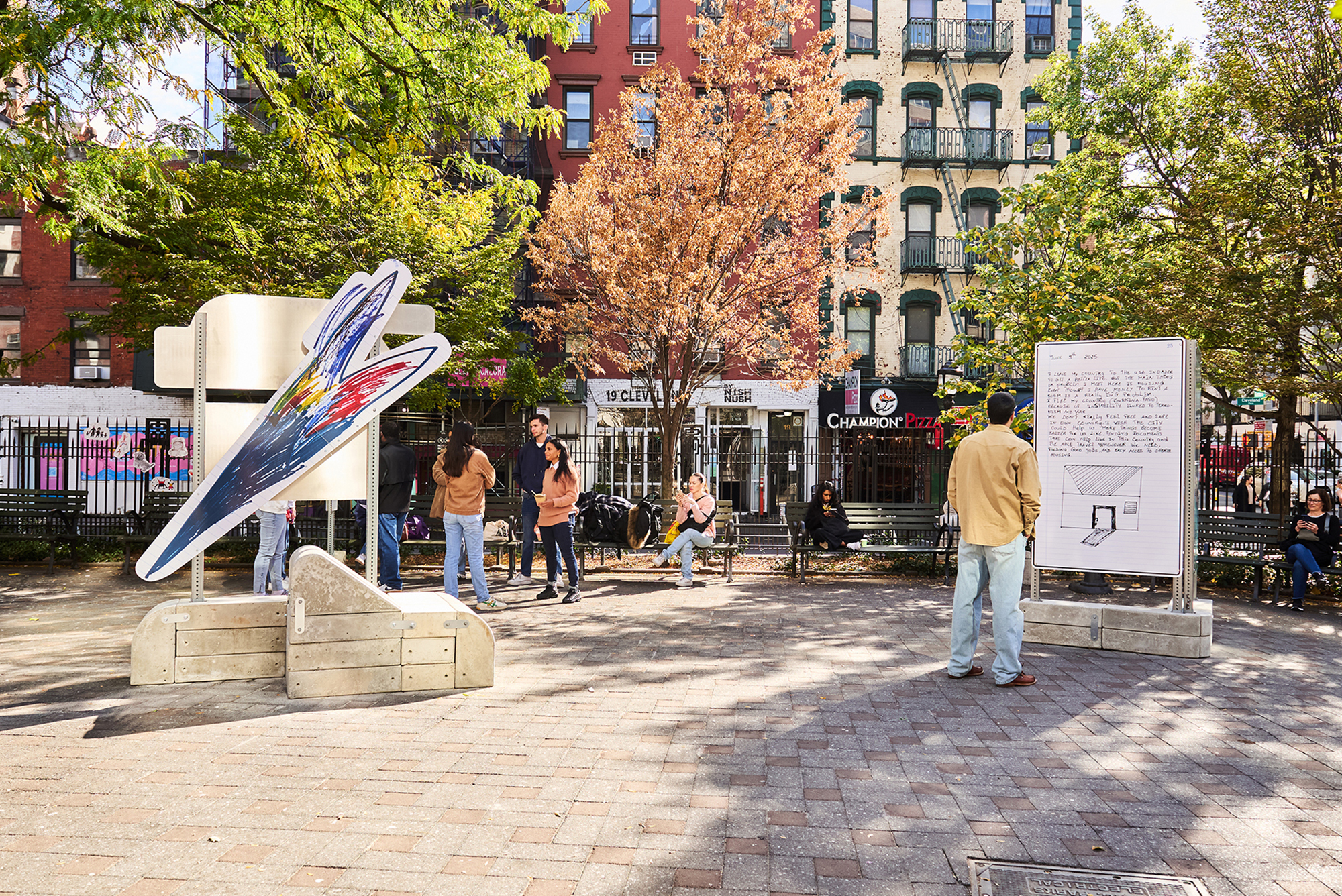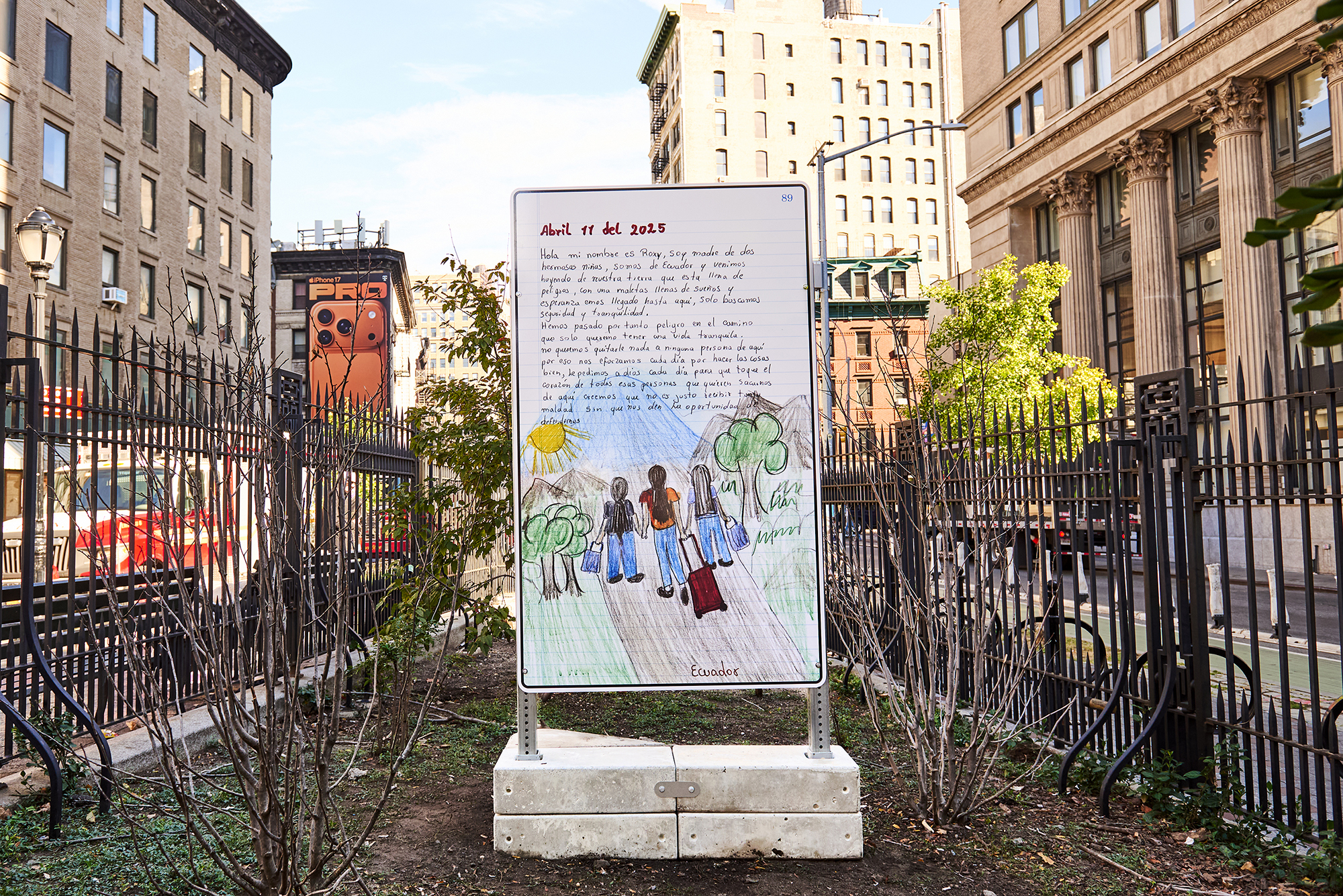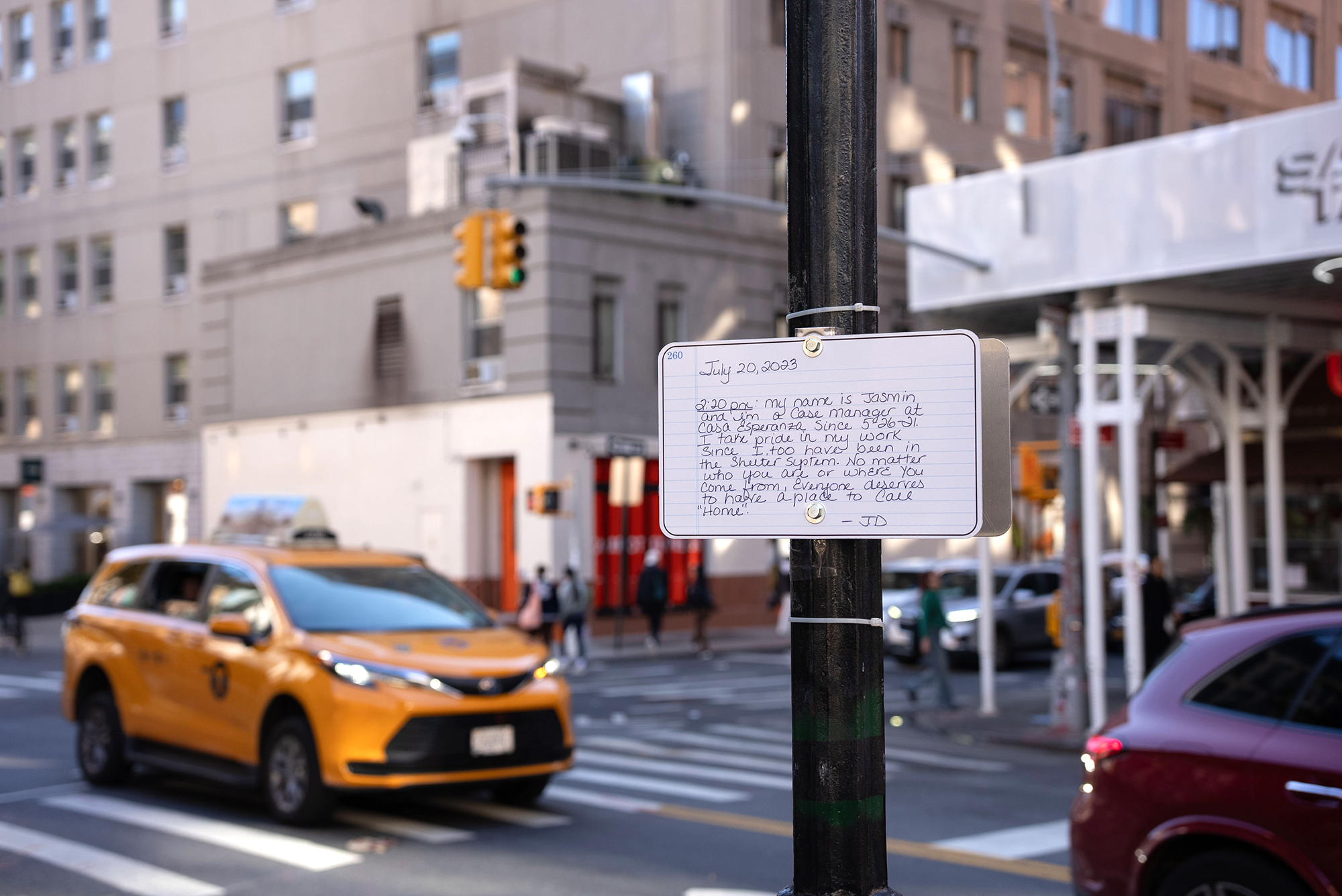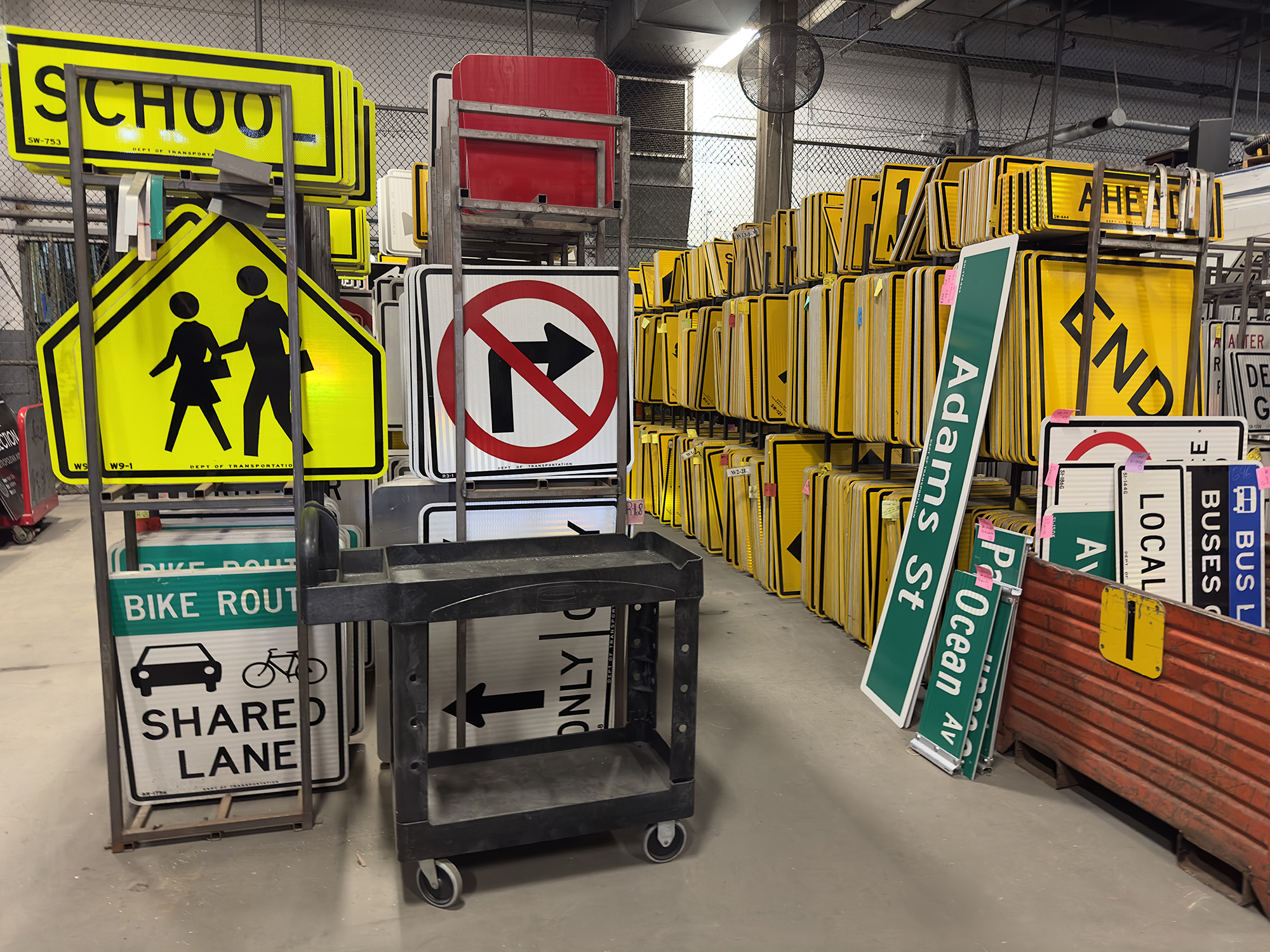
Public Address, 2025-, iterative public artwork consisting of handwritten log entries, upcycled aluminum city street signs, concrete, and steel, Petrosino Square in Manhattan, curated by Guillermo Ruiz de Teresa, commissioned by the Storefront for Art and Architecture and the NYC Department of Cultural Affairs and in partnership with NYC Department of Homeless Services and NYC Parks, Petrosino Square, New York, NY







Public Address, 2025-, sidewalk intervention consisting of upcycled aluminum city street signs, 8.5x11”, 13 signs across Manhattan, commissioned by the Storefront for Art and Architecture and the NYC Deptartment of Cultural Affairs and in partnership with NYC Department of Homeless Services and DOT Art



New York City remains the only municipality in the United States to guarantee the right to shelter, a commitment established through decades of advocacy and litigation. Public Address is an evolving, iterative citywide public artwork commissioned by the Storefront for Art and Architecture that centers the lived experience of those most impacted by housing insecurity. The project emerges from my ongoing role as Public Artist in Residence with the NYC Department of Homeless Services and the Department of Cultural Affairs, a position I’ve held since 2022. Public Address establishes a dialogue with New York City, affirming access to temporary shelter as a basic right while also exposing the limits of such provision in addressing deeper crises of affordability, displacement, and care.
Drawing on my experience as an educator, I have led over 200 multilingual “log-writing” workshops in dozens of shelters across the boroughs. Traditionally an internal form of record-keeping, these logs are instead used for public testimony and personal expression. The entries span housing insecurity, navigating shelter, migration, caregiving, and resistance, offering space for both advocacy and reflection. Participants have the option to be anonymous and to contribute in any language. Over 300 people have contributed to date, and I continue to hold log writing sessions.
Through extensive conversations and inter-agency negotiations, I worked to bring the Department of Transportation on as a partner. The handwritten log entries are printed onto upcycled aluminum city street signs fabricated by the DOT printshop. Public Address materially draws upon and subverts the authority of official signage, replacing bureaucratic language with personal, handwritten, and drawn interventions.
Over the course of a year, five large-scale installations—one per borough—will rotate through NYC Parks. These installations are designed for deep listening and respite, in a city where public space is increasingly privatized. One sign per community district will be installed and affixed to lampposts across the city, prompting passersby to pause and engage. As the project grows and iterates across the city, new entires will be integrated in real time.
Public Address is being realized in partnership with the nonprofit Commonpoint, so that participants in their construction job training program can be hired to install and deinstall the work as it moves across the city. The installations are activated transdisciplinary public programming focused on housing justice, migrant rights, the criminalization of homelessness, and community-driven systems such as mutual aid networks, tenants’ unions, and community land trusts.
By embedding testimony within the visual and spatial codes of the city, Public Address amplifies voices too often excluded from public discourse while foregrounding ways in which civic infrastructures can be reimagined as platforms for listening. Most importantly, the project’s public presence offers unhoused people and staff an unprecedented space for their voices to be centered and heard.
︎︎︎ Map of individual signs across Manhattan
︎︎︎
Storefront for Art and Architecture newsprint featuring texts by curator Guillermo Ruiz de Teresa and Department of Cultural Affairs Assistant Commissioner Kendal Henry
Drawing on my experience as an educator, I have led over 200 multilingual “log-writing” workshops in dozens of shelters across the boroughs. Traditionally an internal form of record-keeping, these logs are instead used for public testimony and personal expression. The entries span housing insecurity, navigating shelter, migration, caregiving, and resistance, offering space for both advocacy and reflection. Participants have the option to be anonymous and to contribute in any language. Over 300 people have contributed to date, and I continue to hold log writing sessions.
Through extensive conversations and inter-agency negotiations, I worked to bring the Department of Transportation on as a partner. The handwritten log entries are printed onto upcycled aluminum city street signs fabricated by the DOT printshop. Public Address materially draws upon and subverts the authority of official signage, replacing bureaucratic language with personal, handwritten, and drawn interventions.
Over the course of a year, five large-scale installations—one per borough—will rotate through NYC Parks. These installations are designed for deep listening and respite, in a city where public space is increasingly privatized. One sign per community district will be installed and affixed to lampposts across the city, prompting passersby to pause and engage. As the project grows and iterates across the city, new entires will be integrated in real time.
Public Address is being realized in partnership with the nonprofit Commonpoint, so that participants in their construction job training program can be hired to install and deinstall the work as it moves across the city. The installations are activated transdisciplinary public programming focused on housing justice, migrant rights, the criminalization of homelessness, and community-driven systems such as mutual aid networks, tenants’ unions, and community land trusts.
By embedding testimony within the visual and spatial codes of the city, Public Address amplifies voices too often excluded from public discourse while foregrounding ways in which civic infrastructures can be reimagined as platforms for listening. Most importantly, the project’s public presence offers unhoused people and staff an unprecedented space for their voices to be centered and heard.
︎︎︎ Map of individual signs across Manhattan
︎︎︎ Storefront for Art and Architecture newsprint featuring texts by curator Guillermo Ruiz de Teresa and Department of Cultural Affairs Assistant Commissioner Kendal Henry
ACTIVATIONS:

“The Right to the City” with writer Jennifer Egan and Will Watts, Deputy Director of Advocacy for Coalition for the Homeless
“The Right to the City: Homelessness and Advocacy” opened the yearlong series of programs with Pulitzer Prize-winning writer Jennifer Egan and Will Watts, Deputy Executive Director for Advocacy at the Coalition for the Homeless. Together, we discussed the current state of homelessness in New York City, the only municipality in the United States that guarantees a right to shelter, a protection won through decades of advocacy and litigation, and the ongoing need for supportive housing and collective accountability. Link to view documentation.

The opening celebration offered free food to anyone attending the exhibition or passing through the park, prepared by EVLoves’s Cafewal. This free restaurant provides free meals and jobs for new New Yorkers.
PROJECT INFRASTRUCTURE:

Research image of log book at DHS shelter

NYC Department of Transportation Sign Shop in Maspeth, Queens where all signs for the project are printed using upcycled aluminum city street signs

Individual sign installation process with DOT

Installation at Petrosino Square with Commonpoint construction training program

EXHIBITION CREDITS: